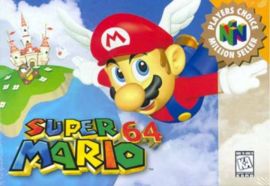Difference between revisions of "Super Mario 64"
WarioFan63 (talk | contribs) |
m (→Legacy) |
||
| Line 30: | Line 30: | ||
==Sequels== | ==Sequels== | ||
| − | At one time, Nintendo was working on ''Super Mario 64 2'' for the [[Nintendo 64DD]], but it was canceled due to the failure of the peripheral. The game slowly turned into ''[[Super Mario Sunshine]]'' for the [[Gamecube]]. | + | At one time, Nintendo was working on ''Super Mario 64 2'' for the [[Nintendo 64DD]], but it was canceled due to the failure of the peripheral. The game slowly turned into ''[[Super Mario Sunshine]]'' for the [[Gamecube]]. It was long believed that a game called ''Super Mario 128'' was in development for the Gamecube as the "true" sequel to ''Super Mario 64'', although it turned out to only be a technology demo, while features of it were later incorporated into ''[[Pikmin]]'' and ''[[Super Mario Galaxy]]''. |
==Ports and Remakes== | ==Ports and Remakes== | ||
Revision as of 10:08, 16 February 2010

| |
| Super Mario 64 | |
| Developer | Nintendo EAD |
| Publisher | Nintendo |
| System | Nintendo 64 Virtual Console |
| Release Date | Nintendo 64 JP June 23, 1996 US September 29, 1996 EU March 1, 1997 JP July, 18, 1997 (Rumble Pak Version) iQue CH November 2003 Virtual Console JP December 2, 2006 US November 19, 2006 EU December 8, 2006 |
| Gallery | GH Gallery |
| Rating | ESRB: K-A |
Super Mario 64 was the first Mario game to feature true 3D. The game has become the standard for 3D platformers and, to a less extent, 3D games in general. This game did away with power suits in favor of different caps. This game was the first appearance of Metal Mario.
Story
One day, Mario receives a letter from Princess Peach asking him to come to her castle and have a piece of cake. When Mario arrives, he discovers that Bowser has taken over the castle imprisoned Peach as well as all of the castle's attendants within various walls and paintings of the castle. Mario must explore the castle and the various worlds that could be accessed through paintings in order to gather the Power Stars that are needed to challenge Bowser and save the princess.
Gameplay
The players controls Mario as he works his way through the various worlds that can be accessed from Princess Peach's Castle, which acts as the game's hub area. Mario is capable of a larger variety of movement than he had ever managed in his 2D games. The power-ups of the previous games are replaced by three special caps. One cap grants flight, another makes Mario invisible, and a third gives Mario a metal suit. The caps don't play as prominent a part as the power suits did in the 2D platformers.
The castle is divided into three different areas: the main floor, the basement, and the second floor. Each area is separated by a locked door. The key can be obtained by defeating Bowser. Each of these floors contain a variety of levels, which are usually accessible by jumping into a painting. Some, however, are hidden and can only be entered by a special method. Each painting is behind a door that requires a certain number of stars to open.
Legacy
The most lasting legacy of Super Mario 64 was it's affect on 3D platformers. Others came before it, but Super Mario 64 was the first game to do it well. Many people tried to copy this game's style. Metal Mario has also become a part of the larger Nintendo universe, by serving as a boss in Super Smash Bros.
Sequels
At one time, Nintendo was working on Super Mario 64 2 for the Nintendo 64DD, but it was canceled due to the failure of the peripheral. The game slowly turned into Super Mario Sunshine for the Gamecube. It was long believed that a game called Super Mario 128 was in development for the Gamecube as the "true" sequel to Super Mario 64, although it turned out to only be a technology demo, while features of it were later incorporated into Pikmin and Super Mario Galaxy.
Ports and Remakes
- In Japan, a special version of the game was rereleased in mid-1997 that supported the Rumble Pak.
- The game was remade as Super Mario 64 DS. The game included thirty new stars and the ability to play as Luigi, Wario, or Yoshi along with Mario as well as various other features.
- The original Nintendo 64 version was released on the Wii's Virtual Console in late 2006.
See Also
| Titles in the Mario Series |
|---|
| Donkey Kong (GB) - Jr. - Mario Bros. - Mario Clash Super Mario Bros. (DX) (Lost Levels - 2 - 3) - Super Mario World - Yoshi's Island - Super Mario Land (2) Super Mario 64 (DS) - Sunshine - Galaxy (2) - 3D Land (World) - Odyssey Super Mario Advance (2 - 3 - 4) - New Super Mario Bros. (Wii - 2 - U) - Run - Wonder Mario vs. Donkey Kong - March of the Minis - Minis March Again! - Mini-Land Mayhem! - Minis on the Move - Tipping Stars Mini Mario & Friends: amiibo Challenge - Super Mario Maker (2) |